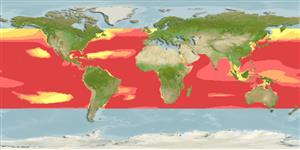Common names from other countries
>
Myctophiformes (Lanternfishes) >
Myctophidae (Lanternfishes) > Notolychninae
Etymology: Notolychnus: Greek, noton = back + Greek, lychnos, -ou = torch (Ref. 45335).
Environment: milieu / climate zone / depth range / distribution range
Ecologia
marino batipelagico; oceanodromo (Ref. 51243); distribuzione batimetrica 25 - 700 m (Ref. 4066). Deep-water; 56°N - 40°S, 180°W - 180°E
Worldwide distribution in tropical, subtropical and temperate waters. Eastern Atlantic: west of British Isles and Bay of Biscay to South Africa. Western Atlantic: Canada to Argentina. Western Pacific: between 0° and 32°S. Eastern Pacific: between 32°N and 30°S, but with 20°S southern limit in Peruvian Transitional Zone. Eastern Indian Ocean: between 9°-32°S.
Length at first maturity / Size / Peso / Age
Maturity: Lm 1.7 range ? - ? cm
Max length : 6.3 cm TL maschio/sesso non determinato; (Ref. 26340)
Spine dorsali (totale) : 0; Raggi dorsali molli (totale) : 10 - 12; Spine anali: 0; Raggi anali molli: 12 - 15; Vertebre: 27 - 31. Branchiostegal rays: 9 (Ref. 31422). Anal organs 8; a single deeply set translucent supracaudal gland present in both sexes, but no infracaudal gland; males have much larger eyes and a longer supracaudal gland than those of females (Ref. 39633).
High-oceanic, epipelagic and mesopelagic (Ref. 4479). Found between 375-700 m during the day and between 25-350 m at night (Ref. 4066). Size stratification with depth during the day only (Ref. 4775). Juveniles migratory; adults migratory, partially migratory or non-migratory (Ref. 4775). Feed on copepods, conchoecid ostracods and euphausiids (Ref. 4775). Oviparous, with planktonic eggs and larvae (Ref. 31442). Also Ref. 58302.
Hulley, P.A., 1990. Myctophidae. p. 398-467. In J.C. Quero, J.C. Hureau, C. Karrer, A. Post and L. Saldanha (eds.) Check-list of the fishes of the eastern tropical Atlantic (CLOFETA). JNICT, Lisbon; SEI; Paris; and UNESCO, Paris. Vol. 1. (Ref. 4479)
IUCN Red List Status (Ref. 130435)
CITES (Ref. 128078)
Not Evaluated
Threat to humans
Harmless
Human uses
Strumenti
Special reports
Download XML
Fonti Internet
Estimates based on models
Preferred temperature (Ref.
115969): 10 - 22.8, mean 15.2 (based on 1055 cells).
Phylogenetic diversity index (Ref.
82804): PD
50 = 1.0000 [Uniqueness, from 0.5 = low to 2.0 = high].
Bayesian length-weight: a=0.00389 (0.00180 - 0.00842), b=3.12 (2.94 - 3.30), in cm Total Length, based on all LWR estimates for this body shape (Ref.
93245).
Trophic level (Ref.
69278): 3.1 ±0.20 se; based on food items.
Resilienza (Ref.
120179): Medio, tempo minimo di raddoppiamento della popolazione 1.4 - 4.4 anni (tmax=1; k >0.30).
Fishing Vulnerability (Ref.
59153): Low vulnerability (10 of 100).
